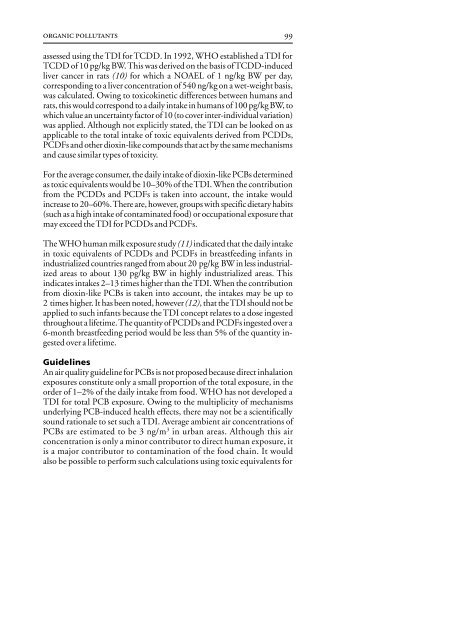Air Quality Guidelines - World Health Organization Regional Office ...
Air Quality Guidelines - World Health Organization Regional Office ...
Air Quality Guidelines - World Health Organization Regional Office ...
Create successful ePaper yourself
Turn your PDF publications into a flip-book with our unique Google optimized e-Paper software.
organic pollutants<br />
assessed using the TDI for TCDD. In 1992, WHO established a TDI for<br />
TCDD of 10 pg/kg BW. This was derived on the basis of TCDD-induced<br />
liver cancer in rats (10) for which a NOAEL of 1 ng/kg BW per day,<br />
corresponding to a liver concentration of 540 ng/kg on a wet-weight basis,<br />
was calculated. Owing to toxicokinetic differences between humans and<br />
rats, this would correspond to a daily intake in humans of 100 pg/kg BW, to<br />
which value an uncertainty factor of 10 (to cover inter-individual variation)<br />
was applied. Although not explicitly stated, the TDI can be looked on as<br />
applicable to the total intake of toxic equivalents derived from PCDDs,<br />
PCDFs and other dioxin-like compounds that act by the same mechanisms<br />
and cause similar types of toxicity.<br />
For the average consumer, the daily intake of dioxin-like PCBs determined<br />
as toxic equivalents would be 10–30% of the TDI. When the contribution<br />
from the PCDDs and PCDFs is taken into account, the intake would<br />
increase to 20–60%. There are, however, groups with specific dietary habits<br />
(such as a high intake of contaminated food) or occupational exposure that<br />
may exceed the TDI for PCDDs and PCDFs.<br />
The WHO human milk exposure study (11) indicated that the daily intake<br />
in toxic equivalents of PCDDs and PCDFs in breastfeeding infants in<br />
industrialized countries ranged from about 20 pg/kg BW in less industrialized<br />
areas to about 130 pg/kg BW in highly industrialized areas. This<br />
indicates intakes 2–13 times higher than the TDI. When the contribution<br />
from dioxin-like PCBs is taken into account, the intakes may be up to<br />
2 times higher. It has been noted, however (12), that the TDI should not be<br />
applied to such infants because the TDI concept relates to a dose ingested<br />
throughout a lifetime. The quantity of PCDDs and PCDFs ingested over a<br />
6-month breastfeeding period would be less than 5% of the quantity ingested<br />
over a lifetime.<br />
<strong>Guidelines</strong><br />
An air quality guideline for PCBs is not proposed because direct inhalation<br />
exposures constitute only a small proportion of the total exposure, in the<br />
order of 1–2% of the daily intake from food. WHO has not developed a<br />
TDI for total PCB exposure. Owing to the multiplicity of mechanisms<br />
underlying PCB-induced health effects, there may not be a scientifically<br />
sound rationale to set such a TDI. Average ambient air concentrations of<br />
PCBs are estimated to be 3 ng/m 3 in urban areas. Although this air<br />
concentration is only a minor contributor to direct human exposure, it<br />
is a major contributor to contamination of the food chain. It would<br />
also be possible to perform such calculations using toxic equivalents for<br />
99

















